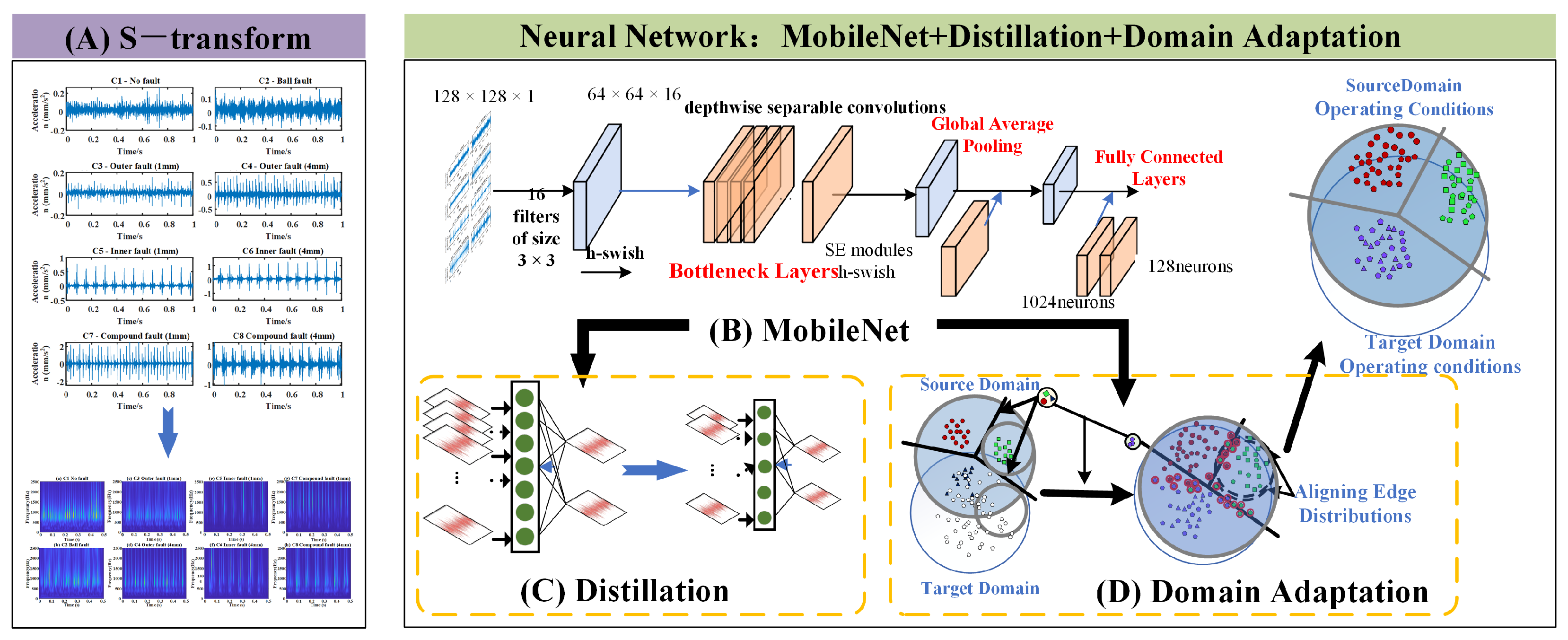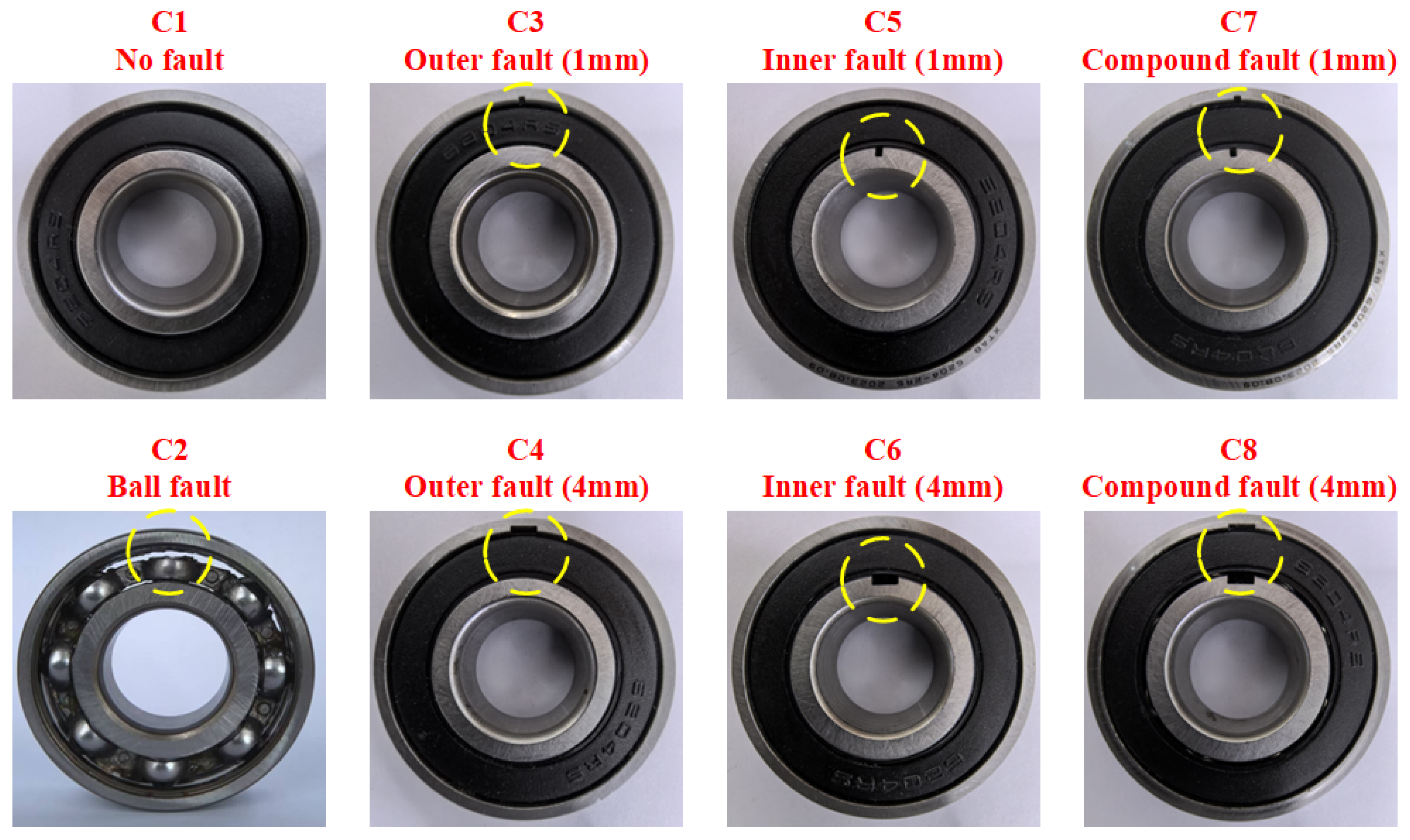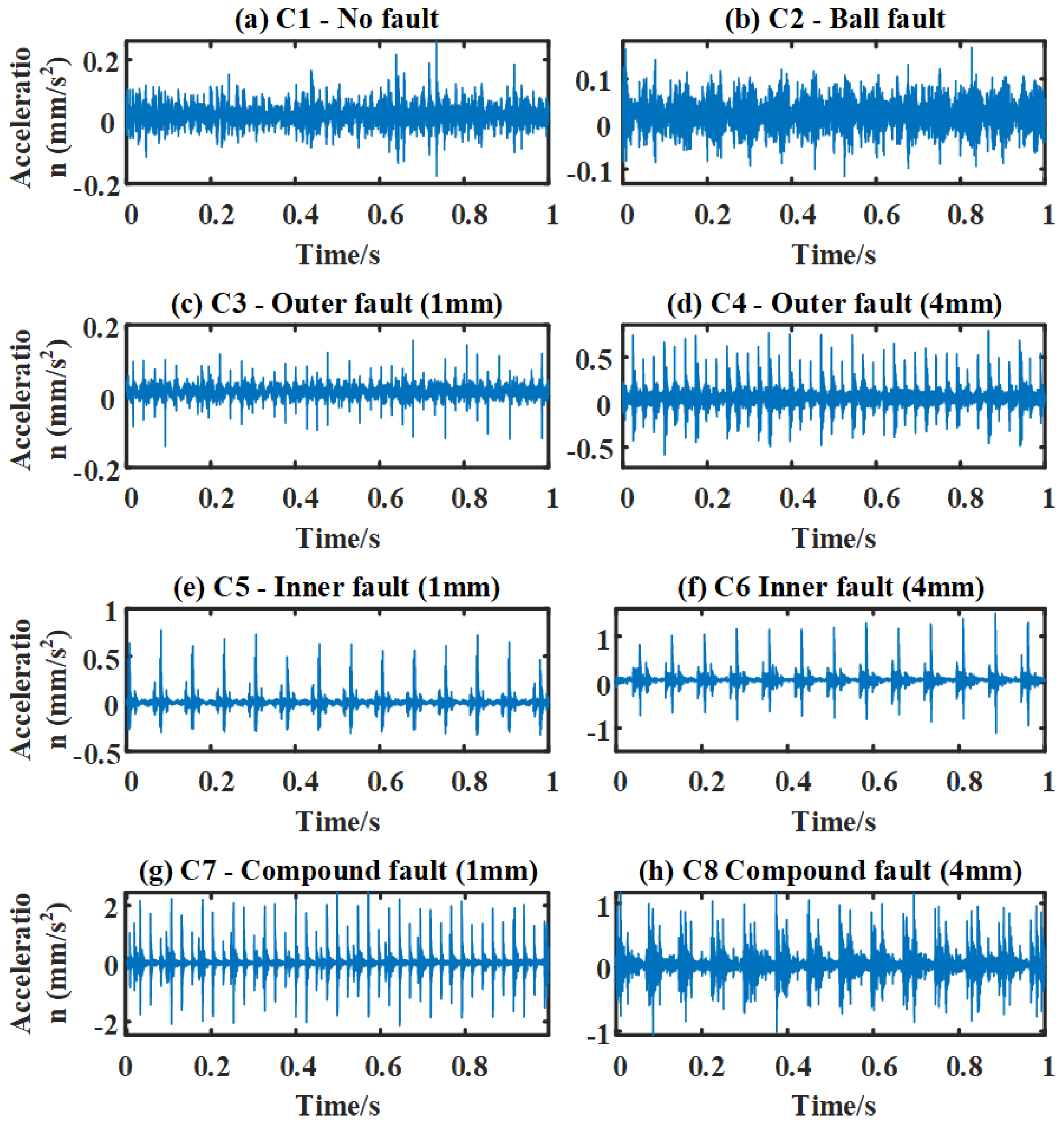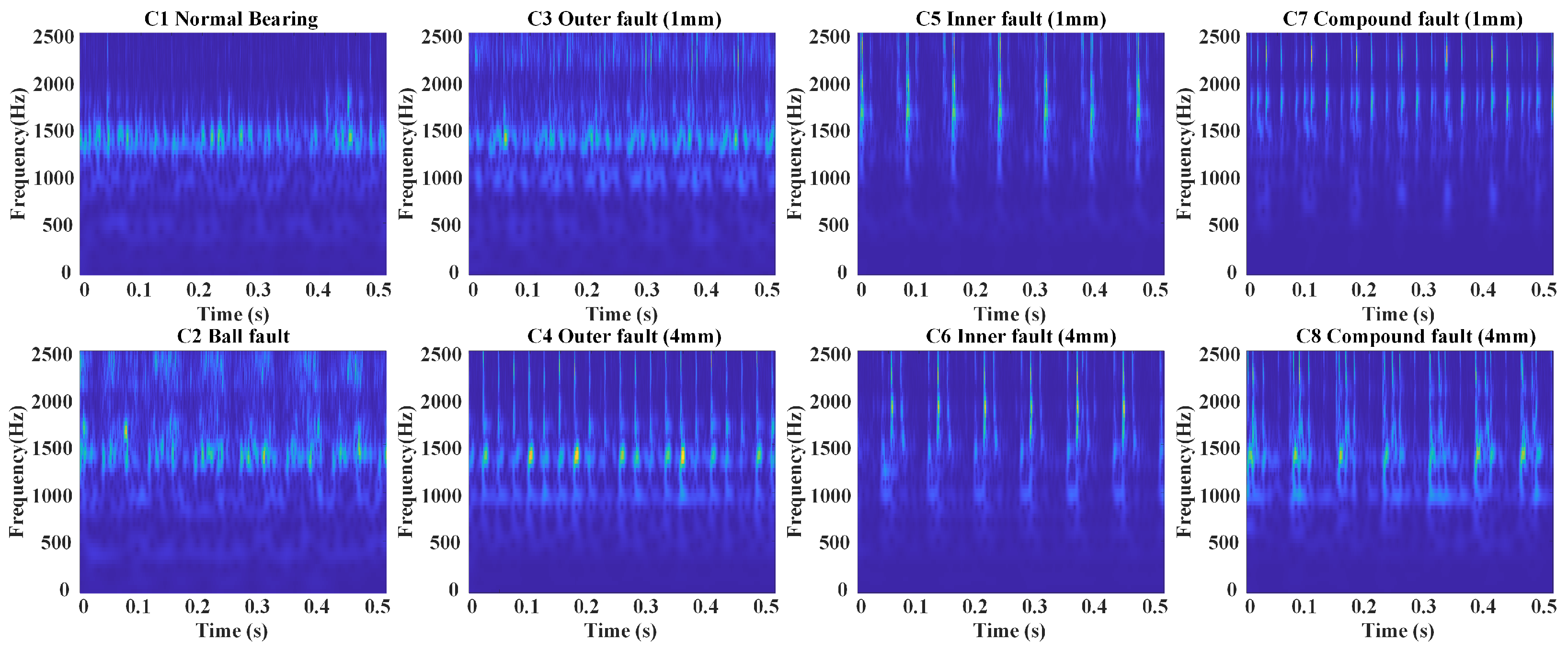A Lightweight Fault Diagnosis with Domain Adaptation for Defected Bearings
Abstract
1. Introduction
1.1. Background
1.2. Related Work
1.3. Challenges
- The ability to combine signal processing with deep learning lies in the effective extraction and utilization of discriminative features from raw signals. Traditional signal processing methods, such as Fourier transform and wavelet analysis, often require extensive domain expertise and may struggle to handle complex, non-stationary signals. While deep learning models can automatically learn features from raw data, they are highly sensitive to noise and variations in signal quality. Balancing the strengths of both approaches to achieve robust feature extraction remains a critical challenge, especially in real-time applications.
- Deep learning model compression is particularly relevant in resource-constrained environments, such as edge devices or embedded systems. Deep learning models, despite their high diagnostic accuracy, often suffer from high computational complexity and large memory requirements, making them difficult to deploy in practical industrial settings. Techniques like pruning, quantization, and knowledge distillation are commonly used to compress models, but these methods often lead to a trade-off between model size and diagnostic performance. Ensuring that compressed models retain their generalization capabilities while reducing computational overhead is a non-trivial task, especially when dealing with complex fault patterns.
- Cross-domain diagnosis and domain adaptation arises from the inherent differences between source and target domains. In real-world industrial scenarios, the distribution of data can vary significantly due to changes in operating conditions, such as load, speed, and environmental noise. This domain shift can severely degrade the performance of fault diagnosis models trained on one domain when applied to another. Domain adaptation techniques aim to align the feature distributions of source and target domains, but achieving effective adaptation without extensive labeled data in the target domain remains a major hurdle. Additionally, the dynamic nature of fault patterns across domains further complicates the development of robust and adaptive diagnostic models.
1.4. Contributions
- The proposed method introduces a novel combination of the S-transform and MobileNet for bearing fault diagnosis. While the S-transform provides a high-resolution time-frequency representation of vibration signals, capturing both the temporal and spectral characteristics of faults, MobileNet serves as an efficient backbone network for feature extraction. This integration leverages the strengths of signal processing and deep learning, enabling the model to extract discriminative features from complex vibration data. Unlike traditional methods that rely on handcrafted features or less efficient deep learning architectures, this approach ensures robust fault detection while maintaining computational efficiency, making it suitable for real-time applications.
- A significant innovation in this work is the application of knowledge distillation to compress the MobileNet backbone, addressing the challenge of deploying deep learning models on edge devices with limited computational resources. By training a lightweight student model to mimic the behavior of a larger teacher model, the proposed method achieves a balance between accuracy and efficiency. This approach not only reduces the model’s size and computational complexity but also retains the rich feature representations learned by the teacher model. This innovation is particularly impaction for industrial applications, where real-time fault diagnosis on embedded systems is critical.
- The proposed technical route establishes an end-to-end framework that seamlessly integrates vibration signal acquisition, time-frequency analysis, deep feature extraction, and model compression. Unlike traditional fault diagnosis methods that often require separate stages for feature extraction and classification, this framework unifies the entire process into a cohesive system. The use of MobileNet and knowledge distillation ensures that the framework is not only accurate but also computationally efficient, enabling real-time deployment. This holistic approach represents a significant advancement in bearing fault diagnosis, offering a practical solution for industrial monitoring and maintenance.
1.5. Organization
2. Methodology
2.1. Overall
2.2. Backbone Design
2.2.1. Time-Frequency Analysis Using S-Transform
2.2.2. Feature Extraction Using Mobilenet
- Input Layer: The input to the network is a single-channel time-frequency matrix of size .
- Initial Convolutional Layer: A convolutional layer with 16 filters of size , stride , and padding ‘same’ is applied, followed by the h-swish activation function. This reduces the spatial dimensions to .
- Bottleneck Layers: A series of bottleneck layers are employed, each consisting of depthwise separable convolutions, Squeeze-and-Excitation (SE) modules, and h-swish activations. The number of output channels in these layers progressively increases from 16 to 160, with intermediate channel sizes of 24, 40, 80, and 112. Strides of are used for downsampling, while strides of maintain spatial resolution.
- Global Average Pooling: A global average pooling layer reduces the spatial dimensions to a vector of size 160.
- Fully Connected Layers: Two fully connected layers with 1024 and 128 neurons, respectively, are applied, each followed by the h-swish activation. The final output layer uses a softmax activation for classification, with the number of neurons equal to the number of classes.
2.3. Knowledge Distillation
2.4. Domain Adaptation
3. Experimental Results
3.1. Hardware Design
3.2. Dataset Description
3.3. Performance Analysis
- Advantage of Time-Frequency Domain Data: Comparing Method 1 and Method 2, the average accuracy for time-frequency domain data increased by 2.8% (from 85.7% to 88.5%). This indicates that time-frequency data contain richer fault feature information, helping the model better capture fault patterns. Similarly, Method 4 (time-frequency domain) is 2.4% higher than Method 3 (time-domain), and Method 6 (time-frequency domain) is 3.4% higher than Method 5 (time-domain). The advantage of time-frequency data is more prominent in complex tasks.
- Effect of Distillation: Comparing Method 1 and Method 3, distillation improved the average accuracy of the time-domain data by 2.6% (from 85.7% to 88.3%). Similarly, comparing Method 2 and Method 4, distillation improved the average accuracy of the time-frequency domain data by 2.2% (from 88.5% to 90.7%). Distillation enhances the model’s generalization ability through knowledge transfer and regularization.
- Effect of Domain Adaptation: Comparing Method 3 and Method 5, domain adaptation increased the average accuracy for time-domain data by 1.8% (from 88.3% to 90.1%). Similarly, comparing Method 4 and Method 6, domain adaptation improved the average accuracy for time-frequency domain data by 2.8% (from 90.7% to 93.5%). Domain adaptation effectively mitigates the data distribution mismatch, especially for time-frequency data.
- Cumulative Effect of Method Combinations: The proposed method (Method 6) achieved the highest average accuracy of 93.5%, outperforming the baseline Method 1 by 7.8%. The combined effect of these techniques shows that distillation and domain adaptation synergistically maximize model performance when applied to time-frequency domain data.
- Generalization Capability: To evaluate the generalization ability, the proposed method was tested on two datasets: Dataset A (Self-Designed Test Platform Dataset) and Dataset B (PU University Dataset), achieving 93.5% and 94.2% accuracy, respectively. This consistency across datasets with varying operational conditions (e.g., speed, load) demonstrates robustness to domain shifts. Furthermore, we evaluated performance under different noise levels (SNR 0 to 10 dB) and fault severities (1mm to 4mm defects), showing less than 3 % accuracy drop, which underscores its adaptability. Moreover, the integration of domain adaptation further ensures feature invariance across domains.
3.4. Comparison with Existing Methods
3.5. Discussion
4. Conclusions
Author Contributions
Funding
Institutional Review Board Statement
Informed Consent Statement
Data Availability Statement
Conflicts of Interest
References
- He, C.; Han, P.; Lu, J.; Wang, X.; Song, J.; Li, Z.; Lu, S. Real-Time Fault Diagnosis of Motor Bearing via Improved Cyclostationary Analysis Implemented onto Edge Computing System. IEEE Trans. Instrum. Meas. 2023, 72, 3524011. [Google Scholar] [CrossRef]
- Ding, A.; Qin, Y.; Wang, B.; Jia, L.; Cheng, X. Lightweight Multiscale Convolutional Networks With Adaptive Pruning for Intelligent Fault Diagnosis of Train Bogie Bearings in Edge Computing Scenarios. IEEE Trans. Instrum. Meas. 2023, 72, 3502813. [Google Scholar] [CrossRef]
- Lu, J.; An, K.; Wang, X.; Song, J.; Xie, F.; Lu, S. Compressed Channel-Based Edge Computing for Online Motor Fault Diagnosis With Privacy Protection. IEEE Trans. Instrum. Meas. 2023, 72, 6505112. [Google Scholar] [CrossRef]
- Li, H.; Hu, G.; Li, J.; Zhou, M. Intelligent Fault Diagnosis for Large-Scale Rotating Machines Using Binarized Deep Neural Networks and Random Forests. IEEE Trans. Autom. Sci. Eng. 2022, 19, 1109–1119. [Google Scholar] [CrossRef]
- Wang, Y.; Wu, J.; Luo, S.; Yu, Z.; Zhou, Q. A Lightweight Reprogramming Framework for Cross-Device Fault Diagnosis in Edge Computing. IEEE Trans. Instrum. Meas. 2025, 74, 3500212. [Google Scholar] [CrossRef]
- Peng, N.; Liang, R.; Wang, G.; Sun, P.; Chen, C.; Hou, T. Edge Computing-Based Fault Location in Distribution Networks by Using Asynchronous Transient Amplitudes at Limited Nodes. IEEE Trans. Smart Grid 2021, 12, 574–588. [Google Scholar] [CrossRef]
- Han, T.; Chao, Z. Fault diagnosis of rolling bearing with uneven data distribution based on continuous wavelet transform and deep convolution generated adversarial network. J. Braz. Soc. Mech. Sci. Eng. 2021, 43, 425. [Google Scholar] [CrossRef]
- Ma, Z.; Fu, L.; Xu, F.; Zhang, L. A physics-based sample generation method for few-shot bearing condition monitoring. Knowl.-Based Syst. 2025, 310, 112952. [Google Scholar] [CrossRef]
- Du, J.; Qin, N.; Huang, D.; Jia, X.; Zhang, Y. Lightweight FL: A Low-Cost Federated Learning Framework for Mechanical Fault Diagnosis With Training Optimization and Model Pruning. IEEE Trans. Instrum. Meas. 2024, 73, 3504014. [Google Scholar] [CrossRef]
- Sun, J.; Liu, Z.; Wen, J.; Fu, R. Multiple hierarchical compression for deep neural network toward intelligent bearing fault diagnosis. Eng. Appl. Artif. Intell. 2022, 116, 105498. [Google Scholar] [CrossRef]
- Huan, L.; Tang, B.; Zhao, C. Global Composite Compression of Deep Neural Network in Wireless Sensor Networks for Edge Intelligent Fault Diagnosis. IEEE Sens. J. 2023, 23, 17968–17978. [Google Scholar] [CrossRef]
- Wang, X.; Hu, D.; Fan, X.; Liu, H.; Yang, C. Intelligent Fault Diagnosis Method Based on Neural Network Compression for Rolling Bearings. Symmetry 2024, 16, 1461. [Google Scholar] [CrossRef]
- Pan, T.; Wang, T.; Chen, J.; Xie, J.; Cao, S. A global and joint knowledge distillation method with gradient-modulated dynamic parameter adaption for EMU bogie bearing fault diagnosis. Measurement 2024, 235, 114927. [Google Scholar] [CrossRef]
- Fu, L.; Yan, K.; Zhang, Y.; Chen, R.; Ma, Z.; Xu, F.; Zhu, T. EdgeCog: A Real-Time Bearing Fault Diagnosis System Based on Lightweight Edge Computing. IEEE Trans. Instrum. Meas. 2023, 72, 2521711. [Google Scholar] [CrossRef]
- Zhang, C.; Qiao, Z.; Li, T.; Kumar, A.; Xu, X.; Li, H.; Li, Z. A teacher-student strategy specific to transformer for machine fault diagnosis. Struct. Health-Monit.-Int. J. 2024. [Google Scholar] [CrossRef]
- An, Y.; Zhang, K.; Chai, Y.; Zhu, Z.; Liu, Q. Gaussian Mixture Variational-Based Transformer Domain Adaptation Fault Diagnosis Method and Its Application in Bearing Fault Diagnosis. IEEE Trans. Ind. Inform. 2024, 20, 615–625. [Google Scholar] [CrossRef]
- Zhang, W.; Li, X.; Ma, H.; Luo, Z.; Li, X. Universal Domain Adaptation in Fault Diagnostics With Hybrid Weighted Deep Adversarial Learning. IEEE Trans. Ind. Inform. 2021, 17, 7957–7967. [Google Scholar] [CrossRef]
- Tang, Z.; Hou, X.; Huang, X.; Wang, X.; Zou, J. Domain Adaptation for Bearing Fault Diagnosis Based on SimAM and Adaptive Weighting Strategy. Sensors 2024, 24, 4251. [Google Scholar] [CrossRef] [PubMed]
- Zhang, H.; Wang, X.; Zhang, C.; Li, W.; Wang, J.; Li, G.; Bai, C. Dynamic Condition Adversarial Adaptation for Fault Diagnosis of Wind Turbine Gearbox. Sensors 2023, 23, 9368. [Google Scholar] [CrossRef]
- Fu, L.; Wang, S.; Chen, R.; Ma, Z.; Ma, J.; Yao, B.; Xu, F. Intelligent Fault Diagnosis of Rolling Bearings Based on an Improved Empirical Wavelet Transform and ResNet Under Variable Conditions. IEEE Sens. J. 2023, 23, 29097–29108. [Google Scholar] [CrossRef]
- Li, G.; Liu, Z.; Zhang, X.; Lin, W. Lightweight Salient Object Detection in Optical Remote-Sensing Images via Semantic Matching and Edge Alignment. IEEE Trans. Geosci. Remote Sens. 2023, 61, 5601111. [Google Scholar] [CrossRef]
- Chen, Z.; Yang, J.; Chen, L.; Jiao, H. Garbage classification system based on improved ShuffleNet v2. Resour. Conserv. Recycl. 2022, 178, 106090. [Google Scholar] [CrossRef]
- Cao, M.; Fu, H.; Zhu, J.; Cai, C. Lightweight tea bud recognition network integrating GhostNet and YOLOv5. Math. Biosci. Eng. 2022, 19, 12897–12914. [Google Scholar] [CrossRef] [PubMed]
- Huang, Q.; Han, Y.; Zhang, X.; Sheng, J.; Zhang, Y.; Xie, H. FFKD-CGhostNet: A Novel Lightweight Network for Fault Diagnosis in Edge Computing Scenarios. IEEE Trans. Instrum. Meas. 2023, 72, 3536410. [Google Scholar] [CrossRef]








| Health States | Conditions Code | Speed | Load | Radial Force | Label |
|---|---|---|---|---|---|
| No fault | N09_M07_F10_K004 | 900 | 0.7 | 1000 | 1 |
| (NF) | N15_M07_F04_K004 | 1500 | 400 | 2 | |
| Outer fault | N09_M07_F10_KA16 | 900 | 1000 | 3 | |
| (OF) | N15_M07_F04_KA16 | 1500 | 400 | 4 | |
| Inner fault | N09_M07_F10_KI18 | 900 | 1000 | 5 | |
| (IF) | N15_M07_F04_KI18 | 1500 | 400 | 6 | |
| Compound fault | N09_M07_F10_KB24 | 900 | 1000 | 7 | |
| (CF) | N15_M07_F04_KB24 | 1500 | 400 | 8 |
| Datasets of the Time-Frequency Images | Rotating Speeds | Health Conditions | Size of the Training/ Testing Samples |
|---|---|---|---|
| Source domain (S) | 800 rpm | Conditions 1–8 | 400*8/200*8 |
| Target domain (T) | 1500 rpm | Conditions 1–8 | 400*8/200*8 |
| Methods | Diagnostic Strategies | Datasets | Average Accuracy | |
|---|---|---|---|---|
| Our Dataset | PU Dataset | |||
| Method 1 | MobileNet | Time domain | 85.7% | 86.3% |
| Method 2 | MobileNet | Time-frequency | 88.5% | 89.7% |
| Method 3 | MobileNet+Distillation | Time domain | 88.3% | 88.6% |
| Method 4 | MobileNet+Distillation | Time-frequency | 90.7% | 91.3% |
| Method 5 | MobileNet+Distillation +Domain Adaptation | Time domain | 90.1% | 90.6% |
| Method 6 | MobileNet+Distillation +Domain Adaptation | Time-frequency | 93.5% | 94.2% |
| Model | Model Parameters | Inference Time |
|---|---|---|
| Teacher model | 32.14k | 20.41 |
| Student model | 8.74K | 9.72 |
| Methods | Parameters | Model Size | Inference Time (ms) | Accuracy (%) | FLOPs |
|---|---|---|---|---|---|
| ResNet [20] | 743.62 k | 2979.9 KB | 203.56 | 98.21 | 222.24 |
| MobileNet [21] | 32.14 k | 145.2 KB | 20.41 | 83.44 | 24.79 |
| ShuffleNet [22] | 25.54 k | 126.1 KB | 13.44 | 80.36 | 20.79 |
| GhostNet [23] | 13.77 k | 67.5 KB | 9.69 | 85.43 | 17.54 |
| CGhostNet [24] | 8.36 k | 46.0 KB | 10.25 | 87.92 | 16.01 |
| Proposed method | 8.74 K | 51.2 KB | 9.91 | 97.69 | 18.52 |
Disclaimer/Publisher’s Note: The statements, opinions and data contained in all publications are solely those of the individual author(s) and contributor(s) and not of MDPI and/or the editor(s). MDPI and/or the editor(s) disclaim responsibility for any injury to people or property resulting from any ideas, methods, instructions or products referred to in the content. |
© 2025 by the authors. Licensee MDPI, Basel, Switzerland. This article is an open access article distributed under the terms and conditions of the Creative Commons Attribution (CC BY) license (https://creativecommons.org/licenses/by/4.0/).
Share and Cite
Jiao, X.; Zhou, Y.; Liu, X.; Ma, Z.; Xu, F. A Lightweight Fault Diagnosis with Domain Adaptation for Defected Bearings. Appl. Sci. 2025, 15, 4579. https://doi.org/10.3390/app15084579
Jiao X, Zhou Y, Liu X, Ma Z, Xu F. A Lightweight Fault Diagnosis with Domain Adaptation for Defected Bearings. Applied Sciences. 2025; 15(8):4579. https://doi.org/10.3390/app15084579
Chicago/Turabian StyleJiao, Xufen, Yixin Zhou, Xuan Liu, Zepeng Ma, and Fang Xu. 2025. "A Lightweight Fault Diagnosis with Domain Adaptation for Defected Bearings" Applied Sciences 15, no. 8: 4579. https://doi.org/10.3390/app15084579
APA StyleJiao, X., Zhou, Y., Liu, X., Ma, Z., & Xu, F. (2025). A Lightweight Fault Diagnosis with Domain Adaptation for Defected Bearings. Applied Sciences, 15(8), 4579. https://doi.org/10.3390/app15084579






